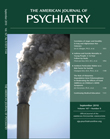Communications and UpdatesFull Access
Published Online:1 Sep 2010https://doi.org/10.1176/appi.ajp.2010.10020261
- Cited by
- 28 December 2022 | Exploration of Neuroprotective Therapy
- 2 December 2021
- 26 March 2020 | International Journal of Neuropsychopharmacology, Vol. 23, No. 7
- 25 February 2013 | Lupus, Vol. 22, No. 3
Metrics
History
Accepted 1 April 2010
Published online 1 September 2010
Published in print 1 September 2010



